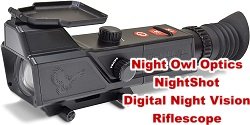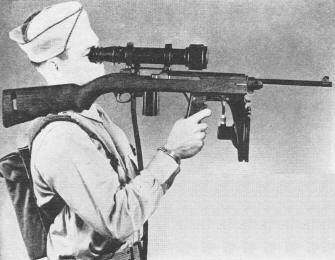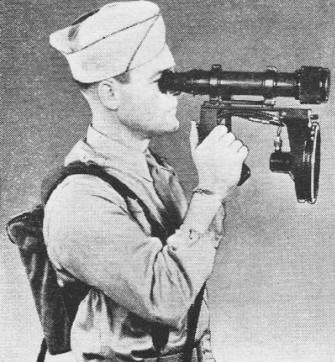Invisible Light Aids Marksman |
||
"What's the big deal about a night vision scope for your rifle?," you might ask, since "I can buy an infrared scope for my rifle on Amazon for under $500." The answer is that no, it is not a big deal now, but in the 1940s while it was being developed and deployed for the military, it was Top Secret.
Invisible Light Aids Marksman Infrared light used in recently revealed wartime development makes possible lull visibility on darkest nights. Peacetime applications are promising.
One of the many secret weapons developed by the U. S. Army during the war has now been released. This device, employing invisible light, made it possible for U. S. Infantrymen and Marines to locate infiltrating troops during the hours of total darkness. This seemingly impossible feat is accomplished by means of an infrared light beam and an electronically operated telescopic sight which together convert an invisible image into a clearly discernible "picture". This infrared instrument was used in two different ways, the specific application being more or less indicated by the name applied to each unit, i.e., the sniperscope and the snooperscope. The sniperscope was mounted on a .30 caliber carbine and was used to locate the enemy for direct annihilation by the user. Under infrared radiation the target became clear, enabling the sniper to fire on the enemy who had the misfortune to be in the area scanned by the scope. The infrared source resembles a fog light in appearance. The glass face of the unit looks like it is painted black. This part of the device is mounted below the barrel of the carbine. The other integral part of the instrument, the telescope, is mounted above the rear sight of the carbine. The entire unit, both infrared source and telescope, is connected by means of a cable conductor to a small power supply which is carried on the sniper's back in a canvas case. The field operation of the sniperscope is extremely simple. A fighter armed with a carbine equipped with this device has only to aim in the general direction of the infiltrating enemy, sight through the telescope and turn on the power supply. He then moves the weapon back and forth across the field like an invisible searchlight until the enemy is sighted. Through the sniperscope the enemy appears to be spotlighted in a light beam of greenish hue. (Through the telescope all objects appear in various shades of green regardless of their natural color). The soldier focuses his telescope to give the clearest image and then presses the trigger of his carbine and another Jap has gone to join his "honorable ancestors". The snooperscope is similar to the snipers cope but the unit is not used in conjunction with a carbine. The telescopic device is mounted on a hand grip with the infrared unit mounted directly below the telescope. This unit is similarly powered by a portable power supply carried on the back. The snooperscope was used to direct gun fire and for signaling. The operating principle of this "night sight" is a combination of electronics and optics and depends on phototubes with associated filters to cut out visible light and transmit only the infrared portion of the spectrum. The telescope receives reflected invisible infrared images at the front end and converts this radiation into visible images which are received at the eyepiece. For the eye to view the scene illuminated by infrared, a specially constructed electronic tube, similar to the 1P25 image tube, is used. It operates as a combination "iconoscope-kinescope." The optical system projects the incoming infrared radiation upon a photo cathode in the "iconoscope" end of the tube. As this screen is sensitive to the infrared light, it emits electrons upon being exposed to such radiation (a photo physical reaction). These electrons, in an electronic image of the scene illuminated by the infrared, pass through a series of electrodes of varying potential and strike a fluorescent screen in the "kinescope" section of the tube in such a manner that the human eye can see a greenish picture of the original scene. The electron lens systems and the accelerating electrodes increase the sensitivity of the tube, and cause the picture on the fluorescent screen to be brighter and to have greater definition. This equipment, when available for civilian purposes, will have several interesting applications. It can be used as a navigation device for ships and other surface craft thus permitting officers and lookouts to see a considerable distance with less eye fatigue on the darkest nights. Obstacles may be detected at sufficiently great distances to prevent collisions. Other vehicles can also be operated in complete darkness with safety. During the war the Army tested this equipment in connection with the operation of locomotives during the hours of darkness. Top picture shows a street scene as viewed by the naked eye during the night hours. The bottom picture shows the same scene as viewed through the sniperscope. The figures which appear white in the picture actually have a greenish cast when viewed by the sniper. Clarity of details enables sniper to score direct hit. In spite of the fact that this equipment was revealed to the public only a short time ago, several police departments have expressed an interest in the infrared "night sight" as a crime detection and prevention device. Undoubtedly other peacetime uses for this unit will be found, where it will augment or replace certain radar applications, but until more extensive civilian tests are made, this weapon stands as a tribute to American ingenuity and "know-how".
Posted April 5, 2022 |
||




